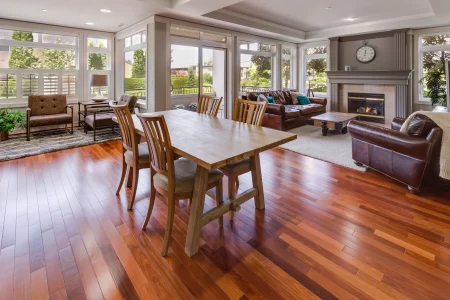 Wood flooring always looks elegant in any room. The rich texture of wood fibers enriches the interior and gives its design a special depth.
Wood flooring always looks elegant in any room. The rich texture of wood fibers enriches the interior and gives its design a special depth.
A wooden floor can completely change the appearance of a home and improve the microclimate thanks to the healing qualities of wood. But this is only if you choose a high-quality floorboard, correctly mount it and properly care for it. We are devoting the publication to these questions today.
Types of wooden boards for the floor
Boards for covering the floor are made from different types of wood. Most often it is pine, spruce, birch, and ash. Oak, maple, alder, beech, and larch are also used for the production of flooring boards.
Solid wood, oak, or ash can withstand heavy loads, so they are used in rooms with the greatest traffic on the floor:
- hallway,
- living room,
- dining room,
- kitchen
- or stairs.
Maple, beech, alder, or birch wood is characterized by medium hardness. Their beautiful texture and color are used in living rooms and bedrooms.
Rooms with high humidity require the use of floorboards made of larch, which is the most rot-resistant of all other types of wood.
That is, the features of floor operation determine which board is better to use in certain rooms.
Conifers boards are relatively soft, so they require more careful care and protection with special paints and varnishes. But the pleasant smell and picturesque texture of the wood of light shades make the pine floor very popular.
Solid wood
Boards for flooring are made from solid wood or jointed lumber. Finger-jointed products are more durable, resistant to deformations, and free of defects. In addition, the jointed board differs in its appearance due to the presence of joints on the products. These boards are more expensive than a solid product.
A solid board made of solid wood can be edged or tongue-and-groove. Edged is usually used for rough floors because gaps can form between edged boards.
Tongue and groove
A tongue-and-groove board has a protrusion on one side and a notch on the other. The tongue and groove on tongue-and-groove boards completely match each other, forming a tight joint without gaps. On the reverse side of the tongue-and-groove board, several longitudinal ventilation slits are made.
A tongue-and-groove board can be mounted on a rough floor, plywood, or concrete. Therefore, it is considered that a tongue-and-groove board is the best option when choosing a floor covering.
But an edged board made of larch, oak or thermal wood (decking) of any species can be a good choice for the floor in a luxurious interior.
Thermo-treated wood
Thermowood is processed under the influence of high temperatures and is intended for conditions of high humidity, usually, these are open areas near the house.
In addition to the terrace thermo-treated wood, a composite board is used for the floor covering of the external areas of the home.
Depending on the number of wood defects, massive floorboards are divided into varieties:
- higher – completely without defects,
- second grade – for paint covering,
- and the third grade – means a rough floor under another coating.
Parquet
This board belongs to the jointed type of floorboards and has three layers:
- upper (provides decorativeness),
- medium (moisture resistance)
- and lower (provides density).
Parquet is perhaps the most widespread floor covering thanks to the:
- aesthetic appeal,
- durability (service life of about 35 years),
- interesting possibilities of laying out in the form of patterns on the floor surface,
- ease of restoring integrity by removing the top layer.
Also, the jointed lumber using for the production of an engineered board, which looks massive, unlike parquet, because it can only be single-striped.
Parquet can be single-, two- or three-striped, that is, it consists of several narrow slats.
Picture Credit: Unsplash



